HONDA PASSPORT 2002 2.G Owners Manual
Manufacturer: HONDA, Model Year: 2002, Model line: PASSPORT, Model: HONDA PASSPORT 2002 2.GPages: 294, PDF Size: 3.97 MB
Page 181 of 294
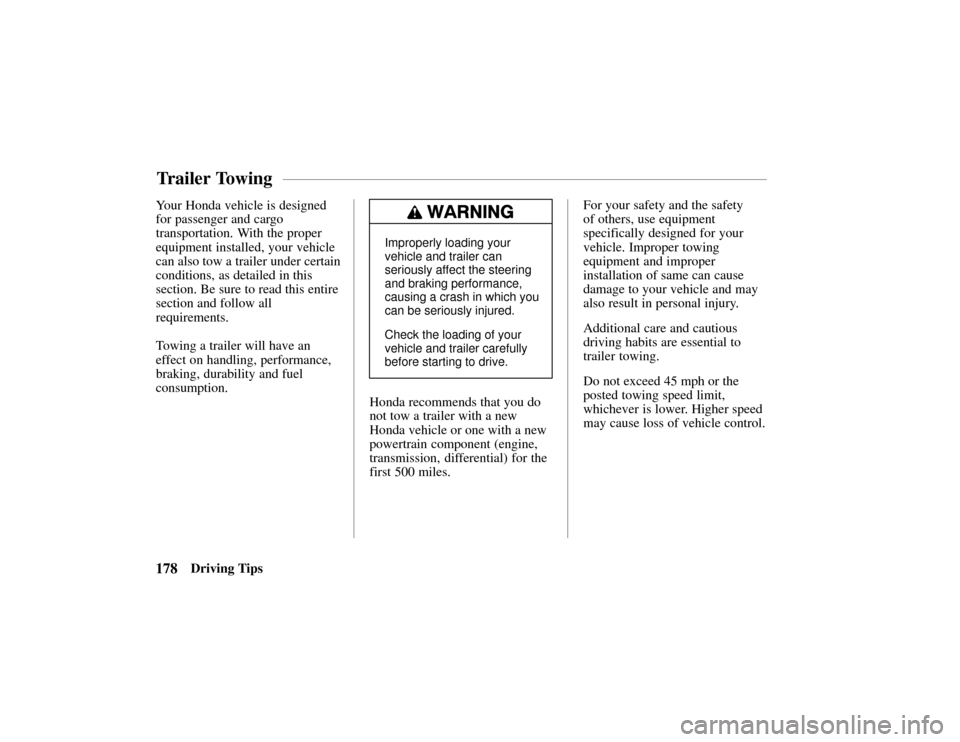
178Driving Tips
Your Honda vehicle is designed
for passenger and cargo
transportation. With the proper
equipment installed, your vehicle
can also tow a trailer under certain
conditions, as detailed in this
section. Be sure to read this entire
section and follow all
requirements.
Towing a trailer will have an
effect on handling, performance,
braking, durability and fuel
consumption.
Improperly loading your
vehicle and trailer can
seriously affect the steering
and braking performance,
causing a crash in which you
can be seriously injured.
Check the loading of your
vehicle and trailer carefully
before starting to drive.
Honda recommends that you do
not tow a trailer with a new
Honda vehicle or one with a new
powertrain component (engine,
transmission, differential) for the
first 500 miles.
For your safety and the safety
of others, use equipment
specifically designed for your
vehicle. Improper towing
equipment and improper
installation of same can cause
damage to your vehicle and may
also result in personal injury.
Additional care and cautious
driving habits are essential to
trailer towing.
Do not exceed 45 mph or the
posted towing speed limit,
whichever is lower. Higher speed
may cause loss of vehicle control.
Trailer Towing
Page 182 of 294

179Driving Tips
Follow the recommendations in
this manual and ask your Honda
dealer for further details before
you tow a trailer with your
Passport.
Towing a trailer affects vehicle
maintenance requirements due
to the additional load. More
frequent maintenance intervals
will be required to assure
continued satisfaction with
your vehicle. Consult your
Honda dealer for recommended
maintenance and service.
The gross trailer weight (trailer
weight plus cargo load) must
never exceed 4,500 lb.
Additional equipment will be
required, depending on the
specific model/load combination.
See “Trailer Hitches” in this
section.
Exceeding the weight limit will
cause damage to your vehicle and
possibly result in personal injury.
•The Gross Vehicle Weight
Rating (
GVWR) is the
combined weight of the
unloaded vehicle, passengers,
cargo, trailer hitch, trailer
tongue load, and optional
equipment. This value is
indicated on the
F.M.V.S.S.
Certification Label on the
driver ’ s doorjamb.
•The Gross Combined Weight
Rating (
GCWR) equals the
combined weight of your
vehicle (including passengers
and cargo) plus the total trailer
load. The following limits
apply.
2WD: 8,700 lb
4WD: 8,950 lb
•The Gross Axle Weight Rating
(
GAWR) is also indicated on
the Certification Label. The
load on either the front or rear
axle resulting from distribution
of the gross vehicle weight on
both axles must not exceed the
values listed. Remember to
account for additional
equipment and tongue load.
Page 183 of 294

180Driving Tips
•Tongue load should be between
9 percent and 11 percent of the
total trailer weight. However, it
should never exceed 450 pounds.
•Never load a trailer with more
weight in the rear than in the
front. The front should be
loaded with approximately
60 percent and the rear with
approximately 40 percent of
the total trailer load.
•Never exceed the maximum
weight limits of the trailer
or trailer towing equipment.
Improper loading can result in
damage to your vehicle and
possible personal injury.
•Check the vehicle and trailer
loading and the weights on
each axle at a commercial scale
or a highway patrol office
equipped with a scale.
Trailer Hitches
A Class 3 hitch kit (up to
4,500 lb) is available from your
Honda dealer.
Use a trailer equipped with
electric brakes and a “Weight
Distributing Hitch Attachment”
when the gross trailer weight
exceeds 3,500 pounds.
A special attachment that replaces
the draw bar/ball assembly is used
to distribute the proper weight to
the front axle. It uses a pair of
spring bars that are adjusted to
accomplish the distribution of the
weight.
Consult your trailer’s
manufacturer for assistance with
selecting the proper weight
distributing hitch attachment. Check with a recreational vehicle
dealer for additional required
equipment. Have this equipment
installed by a trained mechanic.
Improper equipment or installation
can damage your vehicle and
cause personal injury.
Do not use axle-mounted hitches
or equipment not designed for
your vehicle.
Do not make any modifications to
the vehicle’
s exhaust, braking, or
electrical system other than those
that are shown in the instructions
for the Honda Trailer Hitch Kit.
Improper modifications can affect
vehicle durability.
Periodic inspection of all added-
on trailer towing equipment is
necessary to assure continued safe
operation.
Page 184 of 294

181Driving Tips
Safety Chain
Always use suitable safety chains
between your vehicle and the
trailer.
Check with your trailer
manufacturer for the required
equipment. Cross the safety
chains under the hitch and attach
them to the trailer hitch hardware.
This will prevent the trailer from
dropping to the ground in the
event the hitch disengages. For
proper use and installation,
consult your trailer manufacturer.
Trailer Lights
Trailer lights and equipment must
comply with federal, state and
local regulations. Check with your
local recreational vehicle dealer
for the requirements in your area.Use only equipment designed for
your vehicle.
Improper equipment or
installation can cause damage to
your vehicle’
s electrical system
and affect your vehicle warranty.
Consult your Honda dealer for
installation.
Tires
Always check the condition of
your vehicle’ s tires and trailer ’s
tires before operation. Replace
worn or damaged tires before
operation.
Inflate tire pressure to the
recommended cold tire pressure
indicated in the tire
manufacturer ’ s warranty booklet
in the glove box packet. Check the tire manufacturer
’s
requirements when replacement
tires are installed on your vehicle.
Trailer tire condition, size, load
rating, and proper inflation
pressure should be in accordance
with the tire manufacturer ’s
specifications. Improper tire size
and inflation can cause tire
failure, possibly resulting in
vehicle damage and personal
injury.
Trailer Brakes
Trailers with a total weight of
1,000 pounds or more require
trailer brakes. If your trailer is
equipped with a braking system,
make sure it conforms to federal,
state, and local equipment
regulations.
Page 185 of 294
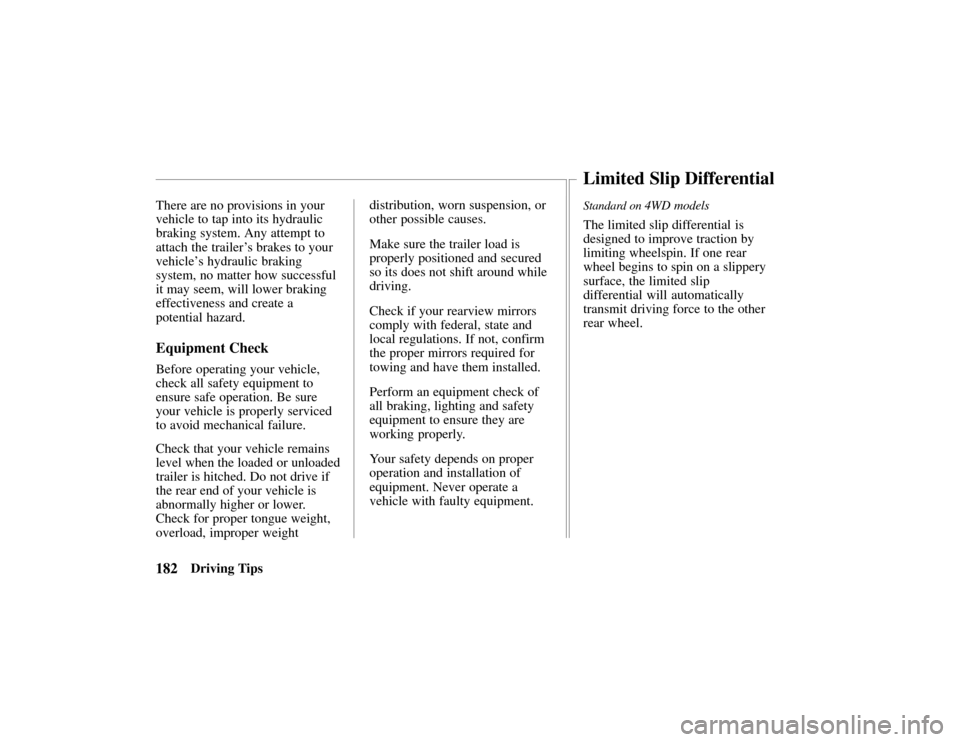
182Driving Tips
There are no provisions in your
vehicle to tap into its hydraulic
braking system. Any attempt to
attach the trailer
’s brakes to your
vehicle’ s hydraulic braking
system, no matter how successful
it may seem, will lower braking
effectiveness and create a
potential hazard.
Equipment Check
Before operating your vehicle,
check all safety equipment to
ensure safe operation. Be sure
your vehicle is properly serviced
to avoid mechanical failure.
Check that your vehicle remains
level when the loaded or unloaded
trailer is hitched. Do not drive if
the rear end of your vehicle is
abnormally higher or lower.
Check for proper tongue weight,
overload, improper weight distribution, worn suspension, or
other possible causes.
Make sure the trailer load is
properly positioned and secured
so its does not shift around while
driving.
Check if your rearview mirrors
comply with federal, state and
local regulations. If not, confirm
the proper mirrors required for
towing and have them installed.
Perform an equipment check of
all braking, lighting and safety
equipment to ensure they are
working properly.
Your safety depends on proper
operation and installation of
equipment. Never operate a
vehicle with faulty equipment.
Standard on 4WD models
The limited slip differential is
designed to improve traction by
limiting wheelspin. If one rear
wheel begins to spin on a slippery
surface, the limited slip
differential will automatically
transmit driving force to the other
rear wheel.
Limited Slip Differential
Page 186 of 294
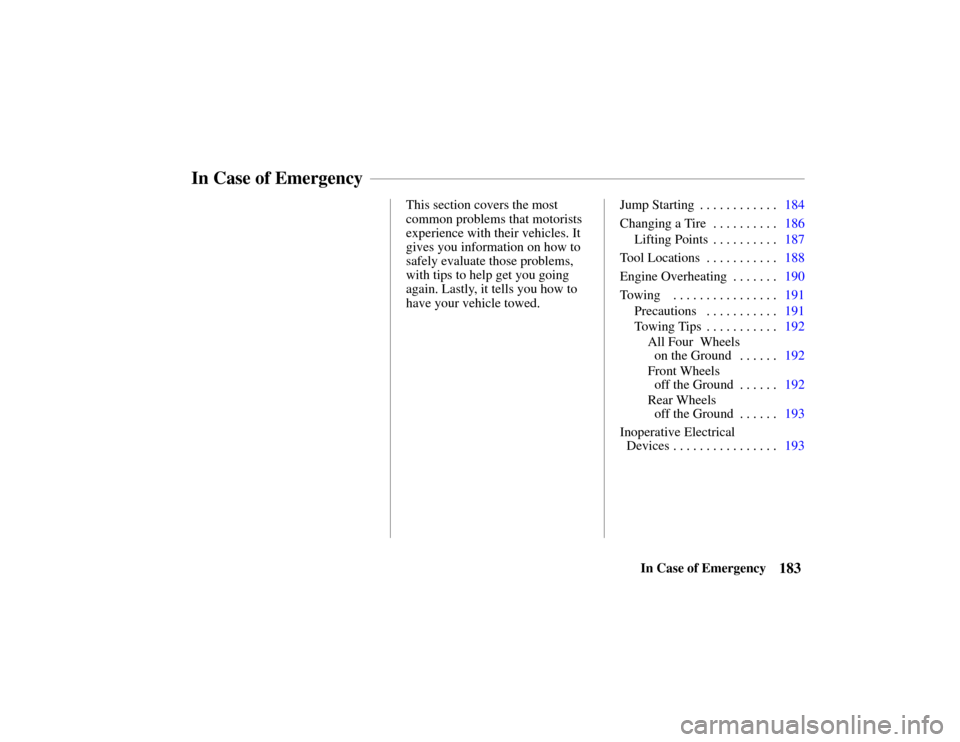
183In Case of Emergency
This section covers the most
common problems that motorists
experience with their vehicles. It
gives you information on how to
safely evaluate those problems,
with tips to help get you going
again. Lastly, it tells you how to
have your vehicle towed.
Jump Starting184
. . . . . . . . . . . .
Changing a Tire186 . . . . . . . . . .
Lifting Points187 . . . . . . . . . .
Tool Locations188 . . . . . . . . . . .
Engine Overheating190 . . . . . . .
Towing 191 . . . . . . . . . . . . . . . .
Precautions191 . . . . . . . . . . .
Towing Tips192 . . . . . . . . . . .
All Four Wheels
on the Ground192 . . . . . .
Front Wheels
off the Ground192 . . . . . .
Rear Wheels
off the Ground193 . . . . . .
Inoperative Electrical
Devices193 . . . . . . . . . . . . . . . .
In Case of Emergency
Page 187 of 294
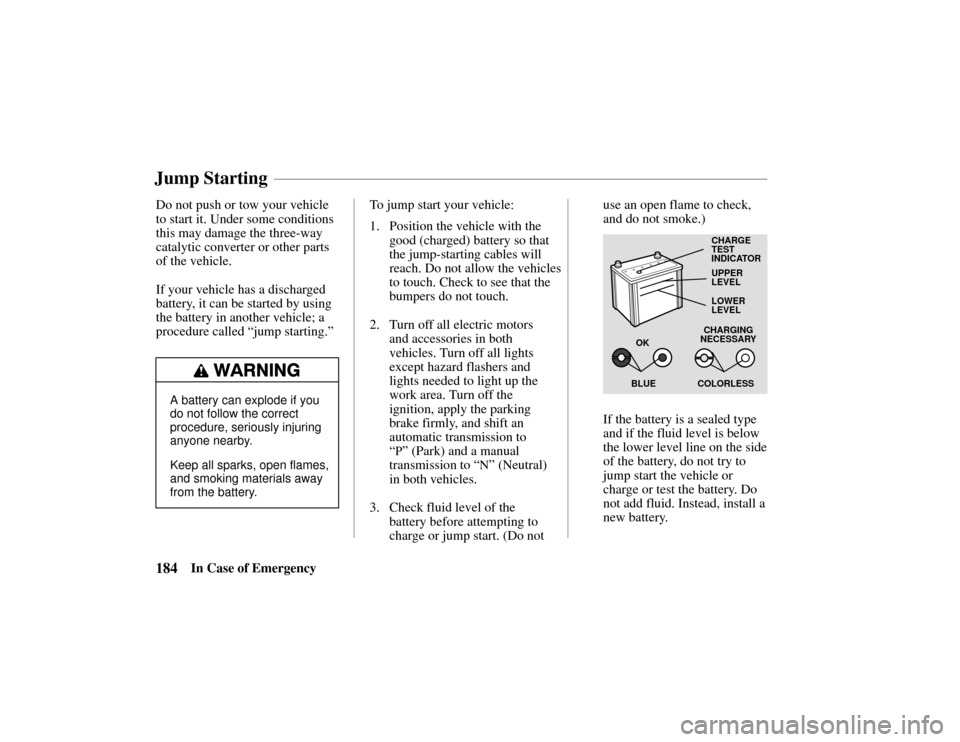
184In Case of Emergency
Do not push or tow your vehicle
to start it. Under some conditions
this may damage the three-way
catalytic converter or other parts
of the vehicle.
If your vehicle has a discharged
battery, it can be started by using
the battery in another vehicle; a
procedure called “jump starting.”
A battery can explode if you
do not follow the correct
procedure, seriously injuring
anyone nearby.
Keep all sparks, open flames,
and smoking materials away
from the battery.
To jump start your vehicle:
1. Position the vehicle with the
good (charged) battery so that
the jump-starting cables will
reach. Do not allow the vehicles
to touch. Check to see that the
bumpers do not touch.
2. Turn off all electric motors and accessories in both
vehicles. Turn off all lights
except hazard flashers and
lights needed to light up the
work area. Turn off the
ignition, apply the parking
brake firmly, and shift an
automatic transmission to
“
P” (Park) and a manual
transmission to “
N” (Neutral)
in both vehicles.
3. Check fluid level of the battery before attempting to
charge or jump start. (Do not use an open flame to check,
and do not smoke.)
CHARGE
TEST
INDICATOR
UPPER
LEVEL
LOWER
LEVEL
CHARGING
NECESSARY
OK
BLUE COLORLESS
If the battery is a sealed type
and if the fluid level is below
the lower level line on the side
of the battery, do not try to
jump start the vehicle or
charge or test the battery. Do
not add fluid. Instead, install a
new battery.
Jump Starting
Page 188 of 294
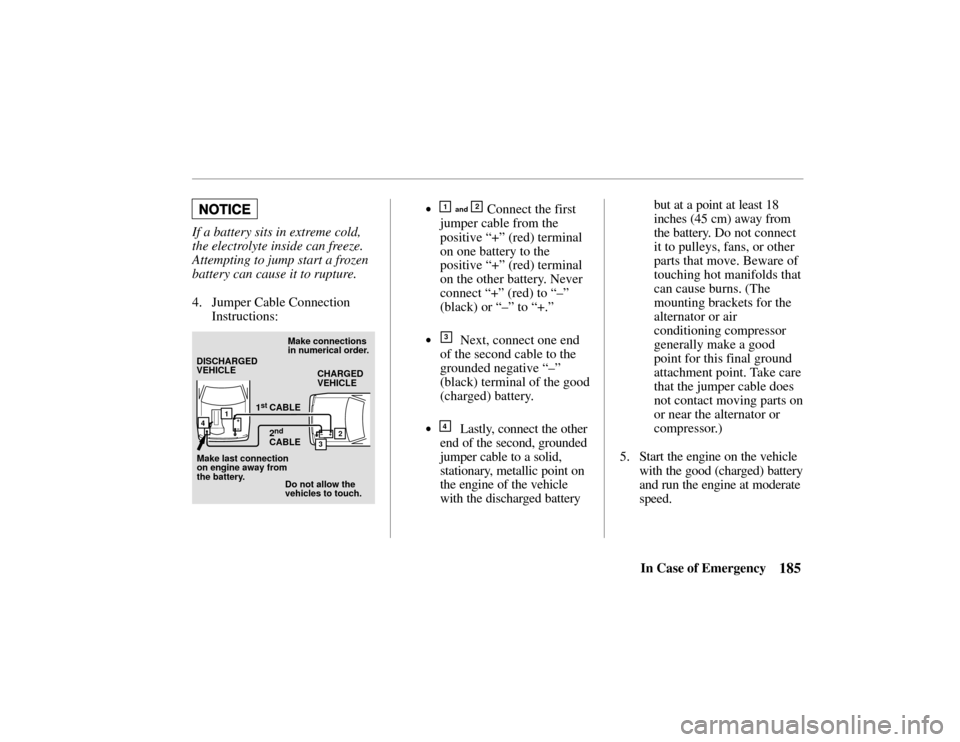
185In Case of Emergency
If a battery sits in extreme cold,
the electrolyte inside can freeze.
Attempting to jump start a frozen
battery can cause it to rupture.
4. Jumper Cable Connection Instructions:
Make connections
in numerical order.
DISCHARGED
VEHICLE CHARGED
VEHICLE
1
st CABLE
2
ndCABLE
Make last connection
on engine away from
the battery. Do not allow the
vehicles to touch.2
3
14
•12
and Connect the first
jumper cable from the
positive “+” (red) terminal
on one battery to the
positive “+” (red) terminal
on the other battery. Never
connect “+” (red) to “–”
(black) or “–” to “+.”
•3 Next, connect one end
of the second cable to the
grounded negative “–”
(black) terminal of the good
(charged) battery.
•4 Lastly, connect the other
end of the second, grounded
jumper cable to a solid,
stationary, metallic point on
the engine of the vehicle
with the discharged battery but at a point at least 18
inches (45 cm) away from
the battery. Do not connect
it to pulleys, fans, or other
parts that move. Beware of
touching hot manifolds that
can cause burns. (The
mounting brackets for the
alternator or air
conditioning compressor
generally make a good
point for this final ground
attachment point. Take care
that the jumper cable does
not contact moving parts on
or near the alternator or
compressor.)
5. Start the engine on the vehicle with the good (charged) battery
and run the engine at moderate
speed.
Page 189 of 294
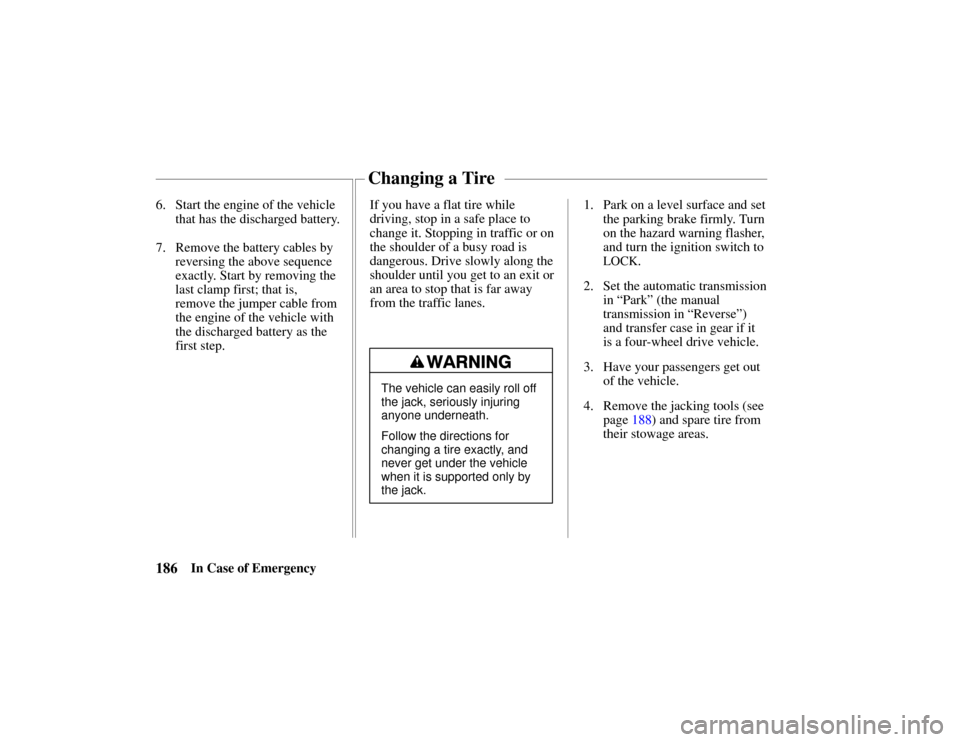
186 In Case of Emergency
6.
Start the engine of the vehicle
that has the discharged battery.
7. Remove the battery cables by
reversing the above sequence
exactly. Start by removing the
last clamp first; that is,
remove the jumper cable from
the engine of the vehicle with
the discharged battery as the
first step. If you have a flat tire while
driving, stop in a safe place to
change it. Stopping in traffic or on
the shoulder of a busy road is
dangerous. Drive slowly along the
shoulder until you get to an exit or
an area to stop that is far away
from the traffic lanes.
The vehicle can easily roll off
the jack, seriously injuring
anyone underneath.
Follow the directions for
changing a tire exactly, and
never get under the vehicle
when it is supported only by
the jack.
1.
Park on a level surface and set
the parking brake firmly. Turn
on the hazard warning flasher,
and turn the ignition switch to
LOCK.
2. Set the automatic transmission
in “Park” (the manual
transmission in “Reverse”)
and transfer case in gear if it
is a four-wheel drive vehicle.
3. Have your passengers get out
of the vehicle.
4. Remove the jacking tools (see
page 188) and spare tire from
their stowage areas.
Changing a Tire
Page 190 of 294
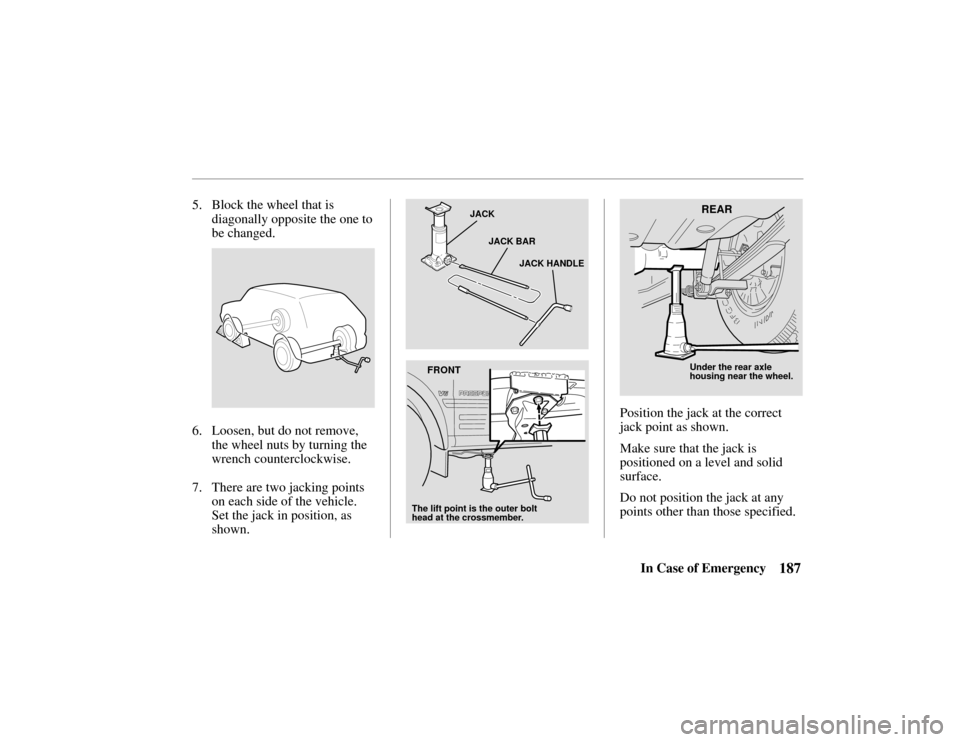
187In Case of Emergency
5. Block the wheel that is
diagonally opposite the one to
be changed.
6. Loosen, but do not remove,the wheel nuts by turning the
wrench counterclockwise.
7. There are two jacking points on each side of the vehicle.
Set the jack in position, as
shown.
JACK BAR
JACK
JACK HANDLE
FRONT
The lift point is the outer bolt
head at the crossmember.
REAR
Under the rear axle
housing near the wheel.
Position the jack at the correct
jack point as shown.
Make sure that the jack is
positioned on a level and solid
surface.
Do not position the jack at any
points other than those specified.